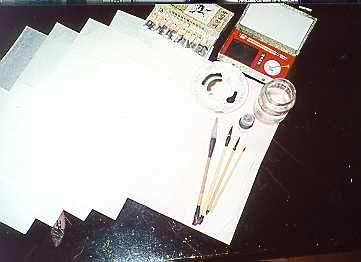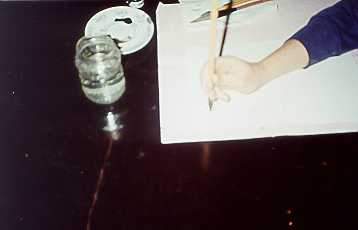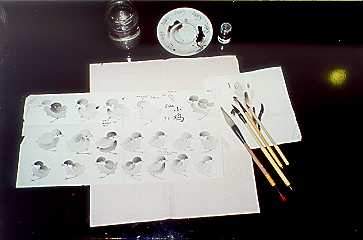
The tradition of Chinese painting dates back to 7th
century. It was developed in several ways, influenced by Japanese and European
painting. Despite this, it preserved its individual character. The pictures
explained thoughts and feelings about some real situation. It was the reason why
they were completed with some caligraphical poem. According to the mood of the
picture and the words of poem the author chose also his own seal – its print in
red wasn´t only sign under picture, but it had a special meaning.
The artsmen saw their job as a mission, so they lived very modestly.
The painting was done on a roll of rice paper or piece of silk. The motifs also appeared
on ceramics, porcelain and fans.
From the end of the 19th century to around 1960s painting was gradually departing from
traditional spiritual approach, it started to depict reality and recently even pass to
abstraction.
From time to time also in Czech Republic we have an opportunity to see an exhibition, which
could give us ideas. Permanent collections are located in the castles ”Zbraslav” and ”Liběchov”.
Maybe you will be successful in buying literature in an antiquarian bookshop or you would look at
books in the library of the ”Náprstkovo muzeum” for inspiration.
Pictures have a different composition to the kind we know. Everything, what that should be
emphasized, is at the front of the picture, in a stronger colour. We don´t find any perspective,
but maybe we can see a wavy line, along which our sight wanders from the bottom to the top, so that
we can feel the depth of the picture.
The copying of masters is still used as a proven method of acquiring painting techniques.
Plant motifs, involved under concept ”genre of flowers and birds” are also the first training steps
of beginners in painting. Usually they start with the bamboo, orchid, plum tree and
chrysanthemum, which are symbols of the seasons and also qualities such as resistance, modesty etc.
Chinese painting is considered to be a relaxation technique. This is because of the difference in
attitude – we are running to the target, but Chinese people are prepared to experience the whole
process of painting.
I´d like to contribute with some instructions to create a nice, pleasant atmosphere and enjoying a
calm time.
You can address your wishes to polar@volny.cz
or to our GuestBook.
Approximately 4 years ago some courses of Chinese painting and calligraphy in the
”Náprstkovo muzeum” were running. The first teacher was Mr. Zheng Jien-Huej, after that Mr.
Straka with his wife A Jin and finally Mr. Xu Kuo-Fu with his wife Zhang
Jing-Hua. Immediately after the courses finished I asked Mr. Xu Kuo-Fu, if he could teach group of
enthusiastic girls privately. He agreed, so we had the opportunity to continue. We met
at first regularly once a week. After birth of his son only once every three weeks. We shared
a lot of fun, especially through understanding each other. One of them even started to study
Chinese, it could be useful for calligraphy. But, from time to time, without interpreters from the
Czech-Chinese community we would be lost. Also, Hong-Kong TV shot a short film about life of
Chinese immigrants, so we were included.
Our teacher taught us step by step how to paint flowers, birds and insects. Our desire to paint
landscapes led to one years training on different types of stones, leaves and trunks of trees,
people, bridges and buildings. These all were mixed together in black and
white, and later water coloured pictures of landscapes.
But pictures alone weren´t enough. Our teacher also teaches us also basic calligraphy and
engraving of seals. In addiction he promised to teach the method of underglueing and framing
our pictures.
The quality of pictures is a reflection of long-term training. A person who has trained longer and assiduously, understandably has better pictures. We are grateful to be told our faults and how to correct them. We aren´t discouraged by lack of success and we continue to paint with pleasure. It´s a plesant method of relaxation.
Personally, I also paint pictures according to patterns from books and I try to paint things,
usual in our surroundings, in the same style.
With the aim of popularizing Chinese painting I wrote two articles for the magazine ”Regena”.
As I indicated in the last paragraph, without long-term training it is impossible to paint such a good picture by yourself. You need to proceed gradually. So, I tried to prepare for you step by step instructions, how to do it.
You can buy most of necessary things, which I reccommend for Chinese painting in specialized shops for artsmen. If you have difficulties with something, I could help you to obtain some materials.

For painting you will need original Chinese brushes. They have an absorbent center,
surrounded by long hairs, which can form a very sharp tip after soaking in the water.
They are also extraordinarily flexible. Both of these qualities enable to you to paint a range
scale of different thicknesses of lines or even areas.
A new brush is quite stiff and hard, because of a preserving substance. After soaking in the water
it is dissolved and the hair of the brush becomes soft and flexible. Which kind of brush do you have
to choose? In the Czech Republic there are two kinds of brushes which you can buy.
The softer ones are white, made of sheep or goat hair and they are suitable for calligraphy.
Harder brushes are made of the hair of other animals, for example deer, hares, foxes,
sables etc., which causes their dark colour and greater flexibility.
From wide range of brushes you will need three sizes to start with:
very thin – for painting outlines and dots,
middle size – suitable for filling areas
large – for painting leaves and other large areas.
In the process of painting, from time to time, you have to remove ink by stirring in
a glass of water. It formes the hair
into a sharp tip and shades of grey don´t get darker and darker.
You have to pay extraordinary attention to the treatment of brushes after use. You have to remove
the remaining ink or colour under a stream of water without touching the hair – fat
could make the next soaking of ink or colour difficult. The washed brushes dry better in a vertical position, hang on
hook on the opposite end from the hair. You can only put the cap on a dry brush, for example only for transport.
A wet brush could be damaged by mould.
For your first attempts you will be satisfied with ordinary Czech black ink. But, it
has a different quality in comparison with original Chinese ink – firstly they
don´t have a gloss.
Chinese inks are made of soot of wood, resin or laquer, so they are more
expensive. Between these inks there are differences in fullness of the black colour, gloss and
lustre. They exist either in liquid form or in solid sticks. In the latter
case you will also need a rubbing ink-stone and in a drop of water patiently rub and rub,
until you obtain a black solution. This stone is usually slightly
sloped, because on the top we can leave the thickest black ink and at the
bottom we will have grey ink diluted in a water.
For that reason it is evident, that diluting liquid ink in a drop of water on a
little plate is easier. You can prepare only a small amount of ink,
which you will use during painting according to your estimate.
After ink has been repeteadly diluted and dried, hard, oxidised bits could form in it, which
could damage your picture. It´s better always to prepare a fresh solution.
Inks also exist in basic colours, but Chinese water-colours in tubes, used for washes and tinting are easier to prepare.
They could be mixed and form new kinds and shades of colours.
For our purpose absorbent paper will be suitable, which could be medium absorbent,
similar to a newspaper. Paper which is not very absorbent is suitable for calligraphy and whereas
very absorbent paper is not suitable at all, because of the uncontrolled expansion of ink or colours.
However, we can use it as a pad or instead of napkin for wiping off surplus ink or colour.
When you are sure of the ability of your hand, you can try painting on rice paper. There are
also a lot of different qualities, names and sizes of rice paper, sometimes combined with cotton or
other plant fibers. It shouldn´t be so thin, thet it might tear.
You don´t have to paint only on paper. Pictures painted on silk look very nice. Silk is
usually impregnated with artificial thickeners or starch in advance.
Chinese people underglue their pictures with several layers of paper, to obtain clear
colours.
In China the brush is held in a different way. We are accustomed to painting by movements of the wrist or fingers, but in China the movements starts from the elbow, in the case of large pictures even from shoulder. You can try it: the whole forearm is lying on the table. The brush is held between three fingers and leant against ring-finger. Wrist is bent up. Reinforcement of brush between fingers is done by pressure of the thumb against the ring-finger. It makes the position of brush upright, perpendicular to the paper. At the beginning it will be awkward for you, but after a couple of strokes you will be used to it.

The arm is lying on the table, wrist upright. The brush is held firmly perpendicular to the paper. When we touch with tip of brush on paper, we can form dots and thin lines.
We pull the soaked brush with the whole tip on the paper – we say poetically that brush is
"sleeping". We obtain a drop-shaped spot.
When we drag a lying brush towards of the handle, we obtain
different long and thick lines, which we can use for forming, for example, leaves of grass.
Changing direction of hair of brush oblique or perpendicular to the direction of pulling could
make different shades of areas. This style of pulling sideways is used, for
example, for painting stems of bamboo. Changing of pressure "light" or "heavy" brush gives us various
textures and shades of spots or lines.
You can try dragging influenced by movement of the elbow or shoulder, while lying or raising your arm.

This could be explained as a putting down or raising up, pushing on the place, interruption or
changing of direction. Don´t underestimate the training of lightness or, in contrast, pressure of brush.
While painting lines the brush is gliding over surface of paper and only its tip is painting an outline.
According to the demands of the subject it is possible to increase the pressure on the paper – then
outline will be thicker. Sometimes it is necessary to stop and change the direction of the line or
even interrupt it. This is evident especially when painting trunks of trees. Because changes are
relatively often we say humorously that we paint with "shaking hand".
Similarly, also we have several possibilities how to work with brush in a horizontal direction.
The easiest way is pulling tip of brush towards us like we pull a string. Opposite is pushing the tip
of the brush away – we can imagine, that we roll a stone.
Of course, we use all position which are between these two extremes: leading brush
from the left to the right, from top to the bottom and oblique, the same way in
the opposite direction.
For this method we need small pointed brush. Mostly we use technique of perpendicular brush, mostly dry black ink. Firm thin lines in one continuous stroke form outlines of subjects, here in our picture, for example, little beak and the legs of chicken. It is also suitable for plum blossom, which we can colour inside, or outside as shade.
A wet brush usually soaked with grey ink, but with the tip slightly soaked in black ink forms shaded spots or lines. Sometimes a spot like this is part of picture, for example, leaves of bamboo or, here in our picture the body of the chicken. Spots, painted one next each other, made with a huge brush, could form a big vine leaf etc. Into the still wet spot, we have to paint with a smaller, dryer brush black ink lines as veins of leaf. The lines expand slightly.
At first we can start training of movements as a list of pattern of lines. It is
nonsense only partly. You will learn different features of your brushes and the necessary movements
and pressures. Also you will know how much diluted ink your brushes can soak up, how much your
papers absorb and finally, what size spots or lines you are able to make. You can wipe off excess into
a napkin or on the side of paper.
Later you have to choose a single part of the picture. And you have to train again and
again, till you are satisfied with the result. We could tell stories of how
many papers we spoilt "before" and "after" with an unexpected movement!
All pictures are actually made in several layers – usually by soaking darker grey shades into
underlined lighter shades of grey. When painting landscapes we can also
dry single layers in a warm place, with hairdryer, with napkin or another
piece of paper. We can make shades with dry brush, or dilute finished painted spots with
a wet brush into a larger area.
We can summarize, that Chinese painting includes:
movements of brushes between position "standing – lying", "light – pressed",
degree of soaking brush between "wet – dry",
colour ink between scale "grey – black"
and everything together in several layers on top of each other.

After good training you can try to paint our picture "Chicken under plum tree". We can divide painting into these parts: the trunk of the plum tree, blossoms and chickens.
With a wet middle-size brush, soaked in grey diluted ink and the tip of brush dipped in black
ink, we paint from the bottom of the trunk a thick, heavy line towards the first
branch. Here we stop for a while, push the brush down and we can continue with a slightly oblique line
(which means the trunk). The line is gradually thinner. What we will see in front must be
darker. Everything in the background must be lighter.
In the places, when the trunk is bend, we will paint side branches.
With a smaller dry black brush we put on the trunk a group of dots as a small damage of
bark of trunk, which indicates the age of tree.
We have to paint blossoms in all phases:
buds, through unrolled blossoms to fully developed blossoms.
With a small wet brush, soaked in grey and the tip dipped in black ink, we put five spots next each
other as the petals of the blossoms. Don´t forget to the change pressure of the brush in some way,
as it is necessary for character and shape of single blossoms.
With a dry black brush we paint two slightly dragged dots under the blossoms, which represents the
small stem of the blossoms. With the tip of the same brush with short fast movements we make lines
for small sticks. Over them we add dots as flying pollen.
Similarly as the spots which form the petals of the blossom, we paint as spots single parts of the
chicken´s body: head, back, belly, tail and little wings.
With dry black ink we make lines and dots which represent the beak, eye, legs - and maybe – a couple
of grains on the floor.

I hope you will paint a nice picture. Sometime later we will advise you how to try
calligraphy and something coloured – wait patiently for a surprise.
You can send your questions to polar@volny.cz
or to our GuestBook.
Keywords: Chinese painting, calligraphy, brushes, ink, paper.